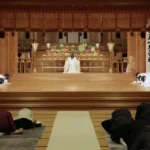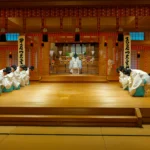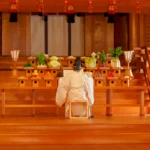The Religious Exposition of 1930

Oomoto demonstrated its internationalist position at the Kyoto Religious Exposition of 1930. Each religion was to build a pavilion on a certain theme. Uncomfortable with Oomoto’s presence among them, the organizers relegated Oomoto to a plot near the entrance.
The other religions featured attractions such as the “Hell Pavilion”, “Heaven Pavilion”, etc. But Oomoto concentrated on arts and international religious affiliations, with a huge wall-painting to symbolize Bankyo Dokon. In the painting, called “The Family of Religions”, Confucius, Buddha, Socrates, Jesus, Shinto gods, and numerous other religious founders and divinities were grouped around a table with a map of the world. Throngs at the Oomoto pavilion reached 20,000 a day, thus confirming the organizers’ worst fears.
The Choseiden Sanctuary
A Temple for All Religions

In 1929, Onisaburo led joint prayer services in Manchuria between Shinto and Tao Yüan, and his visit was followed up in 1931 and 1932 by his son-in-law, Hidemaru Deguchi (husband of Third Oomoto Spiritual Leader Naohi).
Amidst the swirl of inter-religious activities in Japan, China and Europe, Onisaburo conceived a new dream: a Temple for All Religions. This temple was to rise above the confines of one religion and speak to all. He chose for the site of this temple the summit of Mt. Tsuruyama in Ayabe, and called the temple the Choseiden (Hall of Immortality).
On August 22, 1931, Onisaburo held the groundbreaking ceremony for what was to be Oomoto’s crowning architectural jewel. The Choseiden took the shape of a cross with the Supreme Deity to be enshrined at the center. Wor-shippers of all creeds could stand in the four branches of the cross and pray from any direction.
Over the next five years, work on the building continued slowly, but the political situation in Japan was changing rapidly for the worse. Onisaburo was making predictions that Japan would become involved in a war which would end disastrously, and in Japan of the 1930’s such statements were extremely dangerous. Increasingly the government began to put pressure on Oomoto.
The Second Oomoto Incident
By December 1935, only the foundation and some of the steps for the four branches of the Choseiden had been completed. So matters stood when on December 8, 1935, the government set out to suppress Oomoto in the Second Oomoto Incident. Police arrested Onisaburo, Sumiko, Hidemaru, and many other followers, and then dynamited and levelled both headquarters in Ayabe and Kameoka. Oomoto’s entire organization crumbled to nothing. The Aizenkai dissolved, the Oomoto branches disbanded, and in the ensuing years of world conflict and revolution, many of the religions Oomoto had made contact with suffered persecutions as well.
All was reduced to dust, the unfinished Choseiden serving as the symbol of Onisaburo’s crushed hopes. It was left to another generation to construct a new framework of religious cooperation, and somewhere, sometime, a new Choseiden.



